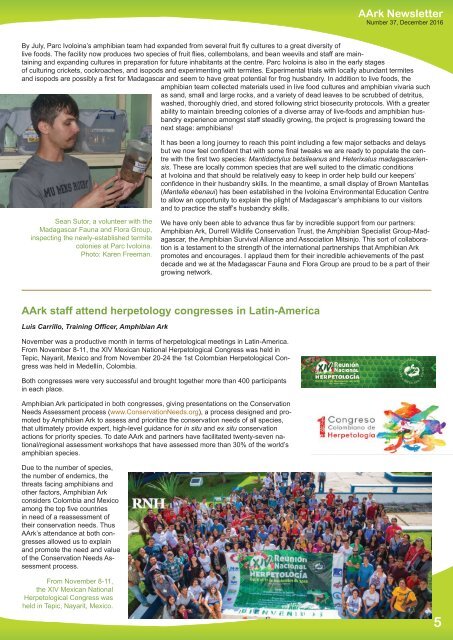amphibian ark
AArk-newsletter-37
AArk-newsletter-37
You also want an ePaper? Increase the reach of your titles
YUMPU automatically turns print PDFs into web optimized ePapers that Google loves.
AArk Newsletter<br />
Number 37, December 2016<br />
By July, Parc Ivoloina’s <strong>amphibian</strong> team had expanded from several fruit fly cultures to a great diversity of<br />
live foods. The facility now produces two species of fruit flies, collembolans, and bean weevils and staff are maintaining<br />
and expanding cultures in preparation for future inhabitants at the centre. Parc Ivoloina is also in the early stages<br />
of culturing crickets, cockroaches, and isopods and experimenting with termites. Experimental trials with locally abundant termites<br />
and isopods are possibly a first for Madagascar and seem to have great potential for frog husbandry. In addition to live foods, the<br />
<strong>amphibian</strong> team collected materials used in live food cultures and <strong>amphibian</strong> vivaria such<br />
as sand, small and large rocks, and a variety of dead leaves to be scrubbed of detritus,<br />
washed, thoroughly dried, and stored following strict biosecurity protocols. With a greater<br />
ability to maintain breeding colonies of a diverse array of live-foods and <strong>amphibian</strong> husbandry<br />
experience amongst staff steadily growing, the project is progressing toward the<br />
next stage: <strong>amphibian</strong>s!<br />
It has been a long journey to reach this point including a few major setbacks and delays<br />
but we now feel confident that with some final tweaks we are ready to populate the centre<br />
with the first two species: Mantidactylus betsileanus and Heterixalus madagascariensis.<br />
These are locally common species that are well suited to the climatic conditions<br />
at Ivoloina and that should be relatively easy to keep in order help build our keepers’<br />
confidence in their husbandry skills. In the meantime, a small display of Brown Mantellas<br />
(Mantella ebenaui) has been established in the Ivoloina Environmental Education Centre<br />
to allow an opportunity to explain the plight of Madagascar’s <strong>amphibian</strong>s to our visitors<br />
and to practice the staff’s husbandry skills.<br />
Sean Sutor, a volunteer with the<br />
Madagascar Fauna and Flora Group,<br />
inspecting the newly-established termite<br />
colonies at Parc Ivoloina.<br />
Photo: Karen Freeman.<br />
We have only been able to advance thus far by incredible support from our partners:<br />
Amphibian Ark, Durrell Wildlife Conservation Trust, the Amphibian Specialist Group-Madagascar,<br />
the Amphibian Survival Alliance and Association Mitsinjo. This sort of collaboration<br />
is a testament to the strength of the international partnerships that Amphibian Ark<br />
promotes and encourages. I applaud them for their incredible achievements of the past<br />
decade and we at the Madagascar Fauna and Flora Group are proud to be a part of their<br />
growing network.<br />
AArk staff attend herpetology congresses in Latin-America<br />
Luis Carrillo, Training Officer, Amphibian Ark<br />
November was a productive month in terms of herpetological meetings in Latin-America.<br />
From November 8-11, the XIV Mexican National Herpetological Congress was held in<br />
Tepic, Nayarit, Mexico and from November 20-24 the 1st Colombian Herpetological Congress<br />
was held in Medellín, Colombia.<br />
Both congresses were very successful and brought together more than 400 participants<br />
in each place.<br />
Amphibian Ark participated in both congresses, giving presentations on the Conservation<br />
Needs Assessment process (www.ConservationNeeds.org), a process designed and promoted<br />
by Amphibian Ark to assess and prioritize the conservation needs of all species,<br />
that ultimately provide expert, high-level guidance for in situ and ex situ conservation<br />
actions for priority species. To date AArk and partners have facilitated twenty-seven national/regional<br />
assessment workshops that have assessed more than 30% of the world’s<br />
<strong>amphibian</strong> species.<br />
Due to the number of species,<br />
the number of endemics, the<br />
threats facing <strong>amphibian</strong>s and<br />
other factors, Amphibian Ark<br />
considers Colombia and Mexico<br />
among the top five countries<br />
in need of a reassessment of<br />
their conservation needs. Thus<br />
AArk’s attendance at both congresses<br />
allowed us to explain<br />
and promote the need and value<br />
of the Conservation Needs Assessment<br />
process.<br />
From November 8-11,<br />
the XIV Mexican National<br />
Herpetological Congress was<br />
held in Tepic, Nayarit, Mexico.<br />
5


